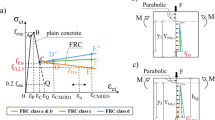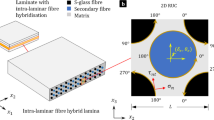Abstract
In this paper, the transverse matrix (resin) cracking developed in multidirectional composite laminates loaded in tension was numerically investigated by a finite element (FE) model implemented in the commercially available software Abaqus/Explicit 6.10. A theoretical solution using the equivalent constraint model (ECM) of the damaged laminate developed by Soutis et al. was employed to describe matrix cracking evolution and compared to the proposed numerical approach. In the numerical model, interface cohesive elements were inserted between neighbouring finite elements that run parallel to fibre orientation in each lamina to simulate matrix cracking with the assumption of equally spaced cracks (based on experimental measurements and observations). The stress based traction-separation law was introduced to simulate initiation of matrix cracking and propagation under mixed-mode loading. The numerically predicted crack density was found to depend on the mesh size of the model and the material fracture parameters defined for the cohesive elements. Numerical predictions of matrix crack density as a function of applied stress are in a good agreement to experimentally measured and theoretically (ECM) obtained values, but some further refinement will be required in near future work.








Similar content being viewed by others
References
Soutis, C.: Fibre reinforced cocmposites in aircraft constrction. Prog. Aerosp. Sci. 41(2), 143–151 (2005)
Abrate, S.: Impact on Composite Structures. Cambridge University Press, Cambridge (1998)
Davies, G.A.O., Olsson, R.: Impact on composite structures. Aeronaut. J. 108(1089), 541–563 (2004)
Kashtalyan, M., Soutis, C.: Analysis of composite laminates with intr- and interlaminar damage. Prog. Aerosp. Sci. 41, 152–173 (2005)
Berbinau, P., Soutis, C., Goutas, P., Curtis, P.T.: Effect of off-axis ply orientation on 0o-fibre microbuckling. Compos. Part A 30, 1197–1207 (1999)
Berbinau, P., Soutis, C., Guz, I.A.: Compressive failure of 0o unidirectional carbon-fibre-reinforced plastic (CFRP) laminates by fibre micobuckling. Compos. Sci. Technol. 59, 1451–1455 (1999)
Anderson, T.L.: Fracture Mechanics – Fundamentals and Applications. CRC Press, New York (1995)
Kashtalyan, M., Soutis, C.: The effect of delaminations induced by transverse cracks and splits on stiffness properties of composite laminates. Compos. Part A 31, 107–119 (2000)
Kashtalyan, M., Soutis, C.: Analysis of local delaminations in composite laminates with angle-ply matrix cracks. Int. J. Solids Struct. 39, 1515–1537 (2002)
Kashtallyan, M.Y., Soutis, C.: Mechanisms of internal damage and their effect on the behaviour and properties of cross-ply composite laminates. Int. Appl. Mech. 38(6), 641–657 (2002)
Kashtalyan, M., Soutis, C.: Stiffness degradation in cross-ply laminates damaged by transverse cracking and splitting. Compos. Part A 31, 335–351 (2000)
Zhang, J., Soutis, C., Fan, J.: Strain energy release rate associated with local delamination in cracked composite laminates. Composites 25(9), 851–862 (1994)
Hashin, Z., Rotem, A.: A fatigue failure criterion for fiber-reinforced materials. J. Compos. Mater. 7, 448–464 (1973)
Hashin, Z.: Failure criteria for uni-directional fibre composites. J. Appl. Mech. 47(1), 329–334 (1980)
Naim, J.A.: The strain energy release rate of composite microcracking: a variational approach. J. Compos. Mater. 23(11), 1106–1129 (1989)
Varna, J., Berglund, L.A.: Multiple transverse cracking and stiffness reduction in cross-ply laminates. J. Compos. Technol. Res. 13(2), 97–106 (1991)
Varna, J., Berglund, L.A.: A model for prediction of the transverse cracking strain in cross-ply laminates. J. Reinf. Plast. Compos. 11(7), 708–728 (1992)
Berglund, L.A., Varna, J.: Thermo-elastic properties of composite laminates with transverse cracks. J. Compos. Technol. Res. 16(1), 77–87 (1994)
Zhang, J., Fan, J., Soutis, C.: Analysis of multiple matrix cracking in [±θ m /90 n ] s composite laminates. Part 1: In-plane stiffness properties. Composites 23(5), 291–8 (1992)
Zhang, J., Fan, J., Soutis, C.: Analysis of multiple matrix cracking in [±θ m /90 n ] s composite laminates. Part 2: Development of transverse ply cracks. Composites 23(5), 299–304 (1992)
Kachanov, L.M.: On the creep rupture time. Izv AN SSSR Otd Tekhn Nauk 8, 26–31 (1958)
Rabotnov, Y.N.: On the Equations of State for Creep. Progress in Applied Mechanics, Prager Anniversary Volume. Macmillan, NewYork (1963)
Donadon, M.V., Iannucci, L., Falzon, B.G., Hodgkinson, J.M., Almeida, S.F.M.: A progressive failure model for composite laminates subjected to low velocity impact damage. Comput. Struct. 86, 1232–1252 (2008)
Faggiani, A., Falzon, B.G.: Predicting low-velocity impact damage on a stiffened composite panel. Compos. Part A 41, 737–749 (2010)
Iannucci, L., Ankersen, J.: An energy based damage model for thin laminated composites. Compos. Sci. Technol. 66, 934–951 (2006)
Yokoyama, N.O., Donadon, M.V., Almeida, S.F.M.: A numerical study on the impact resistance of composite shells using an energy based failure model. Compos. Struct. 93, 142–152 (2010)
Shi, Y., Swati, T., Soutis, C.: Modelling damage evolution in composite laminates subjected to low velocity impact. Compos. Struct. 94, 2902–2913 (2012)
Han, Y., Hahn, H.T., Croman, R.B.: A simplified analysis of transverse ply cracking in cross-ply laminates. Compos. Sci. Technol. 31, 165–177 (1988)
Hahn, H.T., Han, Y.M., Kim, R.Y.: Resistance curves for ply cracking in composite laminates. Proc 33rd Int SAMPE Symp. 1101–8 (1998)
Fan, J., Zhang, J.: In-situ damage evolution and micro/macro transition for laminated composites. Compos. Sci. Technol. 47(2), 107–118 (1993)
Camanho, P.P., Dávila, C.G.. Mixed-Mode decohesion finite elements for the simulation of delamination in composite materials. Tech. Rep. NASA/TM-2002-211737 (2002).
ABAQUS.: ABAQUS Version 6.10, Dessault systemes. Providence (2010).
Turon, A.: Simulation of delamination in composites under quasi-static and fatigue loading using cohesive zone models. PHD Dissertation, Universitat de Girona (2006)
Ankersen, J., Davies, G.A.O.: Interface elements–advantages and limitations in CPRP delamination modelling. In 17th International Conference on Composite Materials, Edinburgh, UK (2009)
Pinho, S.T., Iannucci, L., Robinson, P.: Fracture toughness of the tensile and compressive fibre failure modes in laminated composites. Compos. Sci. Technol. 66(13), 2069–2079 (2006)
Turon, A., Dávila, C.G., Camanho, P.P., Costa, J.: An engineering solution for mesh size effects in the simulation of delamination using cohesive zone models. Engng. Fract. Mech. 74, 1665–1682 (2007)
Daudeville, L., Allix, O., Ladevèze, P.: Delamination analysis by damage mechanics: Some applications. Compos. Engng. 5(1), 17–24 (1995)
Gonçalves, J.P.M., de Moura, M.F.S.F., de Castro, P.M.S.T., Marques, A.T.: Interface element including point-to-surface constraints for three dimensional problems with damage propagation. Egngn. Comput. 17(1), 28–47 (2000)
Mi, Y., Crisfield, M.A.: Analytical Derivation of Load/Displacement Relationships for Mixed-Mode Delamination and Comparison with Finite Element Results. Imperial College, Department of Aeronautics, London (1996)
Schelleckens, J.C.J., de Borst, R.: On the numerical integration of interface elements. Int. J. Numer. Methods. Engng. 36, 43–66 (1993)
Zou, Z., Reid, S.R., Li, S., Soden, P.D.: Modelling interlaminar and intralaminar damage in filment wound pipes under quasi-static indentation. J. Compos. Mater. 36, 477–499 (2002)
Camanho, P.P., Dávila, C.G., de Moura, M.F.: Numerical simulation of mixed-mode progressive delamination in composite materials. J. Compos. Mater. 37(16), 1415–1438 (2003)
Wang, A.S.D.: Fracture mechanics of sublaminate cracks in composite materials. Compos. Technol. Rev. 6, 45–62 (1984)
Crossman, F.W., Wang, A.S.D.: The dependence of transverse cracks and delamination on ply thickness in graphite-epoxy laminates. Damage Compos Mater op. ct. 118–39
Author information
Authors and Affiliations
Corresponding author
Rights and permissions
About this article
Cite this article
Shi, Y., Pinna, C. & Soutis, C. Interface Cohesive Elements to Model Matrix Crack Evolution in Composite Laminates. Appl Compos Mater 21, 57–70 (2014). https://doi.org/10.1007/s10443-013-9349-0
Received:
Accepted:
Published:
Issue Date:
DOI: https://doi.org/10.1007/s10443-013-9349-0




